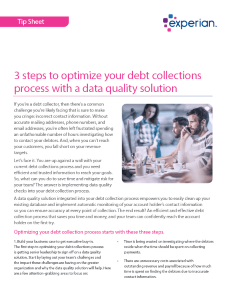- Products

Enjoy a free 30-day trial of our
data validation software.Experience the power of trusted data
solutions today, no credit card required! - Solutions

Enjoy a free 30-day trial of our
data validation software.Experience the power of trusted data
solutions today, no credit card required! - Partners

Enjoy a free 30-day trial of our
data validation software.Experience the power of trusted data
solutions today, no credit card required! - Learn more
- Pricing
- Contact Us
3 steps to optimize your debt collections process with a data quality solution
If you’re a debt collector, then there’s a common challenge you’re likely facing that is sure to make you cringe: incorrect contact information. Without accurate mailing addresses, phone numbers, and email addresses, you’re often left frustrated spending an unfathomable number of hours investigating how to contact your debtors. And, when you can’t reach your customers, you fall short on your revenue targets.
Let’s face it. You are up against a wall with your current debt collections process and you need efficient and trusted information to reach your goals. So, what can you do to save time and mitigate risk for your team? The answer is implementing data quality checks into your debt collection process.
A data quality solution integrated into your debt collection process empowers you to easily clean up your existing database and implement automatic monitoring of your account holder’s contact information so you can ensure accuracy at every point of collection. The end result? An efficient and effective debt collection process that saves you time and money, and your team can confidently reach the account holder on the first try.
Optimizing your debt collection process starts with these three steps.
1. Build your business case to get executive buy-in.
The first step to optimizing your debt collections process is getting senior leadership to sign off on a data quality solution. Start by laying out your team’s challenges and the impact these challenges are having on the greater organization and why the data quality solution will help. Here are a few attention-grabbing areas to focus on:
- Time is being wasted on investigating where the debtors reside when the time should be spent on collecting payments.
- There are unnecessary costs associated with outstanding revenue and payroll because of how much time is spent on finding the debtors due to inaccurate contact information.
- The business is experiencing increased risk because inaccurate contact information is causing unnecessary costs, slowing revenue collection, and creating a bad reputation.
Your C-suite team cares about how the lack of efficiency and effectiveness are impacting the business. If you’re looking for a positive twist for your business case, think about including the light around having a data solution. When you implement data management practices, your business will begin to trek down the road to becoming data-driven. This is a hot topic right now and will help you get that stamp of approval so you can start executing your new data project.
2. Work with your business’s data experts to execute your new data project.
Once you get the green light on your data quality solution, it’s time to start executing. Find the data experts in your business to help you find the best solution. Your team of experts could be your data engineers, or it could be your IT group. Once you pull together your A-team, evaluate data quality vendors that will be best integrated with your current platforms and your team’s culture.
3. Start cleaning up your database with accurate contact information.
Once you find the data quality solution that best integrates with your current tech stack and meets your team’s standards, you can now start cleaning up your database giving you the correct contact information your team has been waiting for. By profiling, cleansing, de-duplicating, and appending your data, your database will be more accurate than ever. And, your database will continue to stay clean with automatic monitoring of your information. These capabilities will make sure your team is always getting the right account holder information, so when they call, email or mail collection notices to the customers, your team is confident they are reaching each person on the first try.
